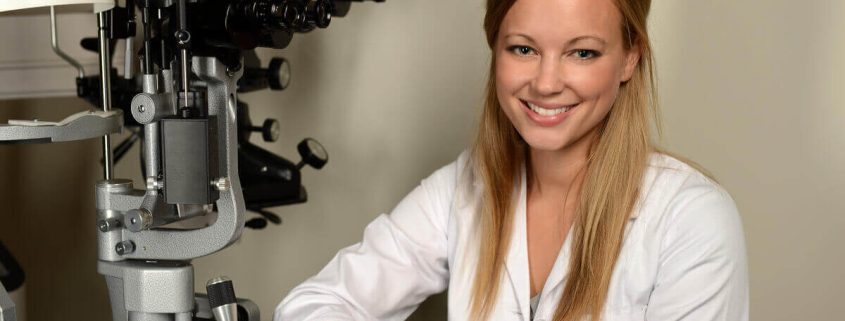What Causes Glaucoma? Everything You Need To Know
Glaucoma is a condition that affects around one in every 50 Australians. This statistic is particularly concerning given that about half of adults who have glaucoma don’t actually know they do, as obvious glaucoma symptoms are rarely encountered. Keep reading to find out about what causes glaucoma, its risk factors, and current glaucoma treatment options.
What Causes Glaucoma?
Glaucoma is a type of optic neuropathy, a disease of the optic nerve of the eye. During glaucoma, the fibres of the optic nerve slowly and progressively become damaged and lost. As we rely on the optic nerve to transmit neural signals from the eyeball to visual processing areas of the brain, this results in a gradual loss of sight. This damage to sight is irreversible. Typically, the loss begins in the mid-periphery of your field of view, but if glaucoma treatment is not initiated, it can progress into tunnel vision or complete blindness.
 Most instances of glaucoma are associated with elevated intraocular pressure, the pressure within the eyeball. This can occur either in the presence of open or narrowed drainage channels in the eye, a structure known as the anterior angle. If the anterior angle is open, the type of glaucoma is termed open-angle glaucoma; if the angle is closed, it’s called angle closure glaucoma. A smaller subcategory of glaucoma develops even when intraocular pressures are within normal range; this is called normotension or low tension glaucoma.
Most instances of glaucoma are associated with elevated intraocular pressure, the pressure within the eyeball. This can occur either in the presence of open or narrowed drainage channels in the eye, a structure known as the anterior angle. If the anterior angle is open, the type of glaucoma is termed open-angle glaucoma; if the angle is closed, it’s called angle closure glaucoma. A smaller subcategory of glaucoma develops even when intraocular pressures are within normal range; this is called normotension or low tension glaucoma.
Experts don’t fully understand what causes glaucoma, though it is observed that lowering the intraocular pressure is core to glaucoma treatment and preserving the optic nerve. At a basic level, doctors know that an imbalance of aqueous fluid production to drainage rate contributes to what causes glaucoma. This can be due to:
- Narrowed anterior angles physically inhibiting the outflow of aqueous fluid
- The anterior angles being open but clogged with debris or pigment cells
- Ocular trauma or inflammation damaging the anterior angle and the ability of fluid to drain out
- Deficient blood circulation and oxygen supply to the optic nerve
- Underlying immune factors
Glaucoma Diagnosis
Glaucoma is often nicknamed the sneak thief of sight as most cases don’t present with glaucoma symptoms. Usually, glaucoma is detected as an incidental finding on a routine visit to your optometrist or ophthalmologist. Your eye care professional will use several different tests to form the diagnosis, and sometimes these tests will need to be performed at least two or three times to create a fuller picture of whether you have progressive glaucoma that needs treatment.
Common tests for diagnosing glaucoma include:
- Tonometry to measure the intraocular pressure
- Fundoscopy to view the optic nerve and assess its features
- Gonioscopy to assess the anterior angles
- Optical coherence tomography (OCT) to measure the thickness of the retinal nerve fibre layer and perform various analyses, such as the progression of nerve thinning
- Visual field testing (VFT) to map out any areas of sight loss in the visual field and monitor the progression of this loss
In most cases, glaucoma develops and progresses very slowly and silently, which is why glaucoma symptoms are rare. Damage to the optic nerve is entirely painless, and we are less attentive to losses in our peripheral sight until the loss is quite advanced. However, for those who develop angle closure glaucoma, their intraocular pressures may increase very high, very suddenly. In these circumstances, angle closure glaucoma symptoms can include:
- Red, very painful eye
- Headache
- Nausea and vomiting
- Haloes around lights and blurry sight
These symptoms present an emergency, and you should go to the hospital immediately.
Glaucoma Treatment
 Treatment of glaucoma is based on reducing the intraocular pressure to a level that preserves the remaining retinal nerve fibres. This can be achieved in several ways. Finding the best glaucoma management strategy for you is done in discussion with your ophthalmologist. You may wish to discuss factors such as the side effects of treatment, potential complications, the burden of the treatment, and how effective it is at slowing the progression of your glaucoma.
Treatment of glaucoma is based on reducing the intraocular pressure to a level that preserves the remaining retinal nerve fibres. This can be achieved in several ways. Finding the best glaucoma management strategy for you is done in discussion with your ophthalmologist. You may wish to discuss factors such as the side effects of treatment, potential complications, the burden of the treatment, and how effective it is at slowing the progression of your glaucoma.
The most common first-line open-angle glaucoma treatment is eyedrops to lower the intraocular pressure. Within this category of drugs known as ocular antihypertensives, there are quite a number of different medications. Glaucoma eyedrops need to be used at least once a day; some up to three times a day. Some people will need more than one type of eyedrop to keep their intraocular pressures under control.
If eyedrops are ineffective or the burden of their side effects or needing to remember to instil them is too great, your ophthalmologist may suggest other treatment solutions. This can include a laser procedure known as selective laser trabeculoplasty to encourage increased fluid outflow through the anterior angle. There are also a number of surgical procedures, including the insertion of microscopic stents or shunts to aid the drainage of aqueous fluid.
For angle closure glaucoma, a laser treatment called a peripheral iridotomy is used to create an extra channel through the coloured iris for fluid outflow. This can also help to widen the anterior angle.
More research is underway to complement the current understanding of what causes glaucoma. There is some evidence that vitamin B3 supplementation can be neuroprotective – that is, it can provide some protection for the optic nerve in glaucoma. Additionally, adhering to a healthy lifestyle of physical exercise, no smoking, and a balanced diet is beneficial for every part of your eyes and body, not just your optic nerves.
Call us now on (03) 9070 3580 for a consultation.
Note: Any surgical or invasive procedure carries risks. Before proceeding, you should seek a second opinion from an appropriately qualified health practitioner.
References
What is Glaucoma?
https://glaucoma.org.au/what-is-glaucoma#:~:text=What%20causes%20glaucoma%3F,optic%20nerve%20varies%20between%20people.
The Pathophysiology and Treatment of Glaucoma.
https://www.ncbi.nlm.nih.gov/pmc/articles/PMC4523637/#:~:text=Primary%20closed%2Dangle%20glaucoma%20is,anterior%20chambers%20at%20the%20pupil.
Glaucoma
https://www.mayoclinic.org/diseases-conditions/glaucoma/symptoms-causes/syc-20372839






Leave a Reply
Want to join the discussion?Feel free to contribute!